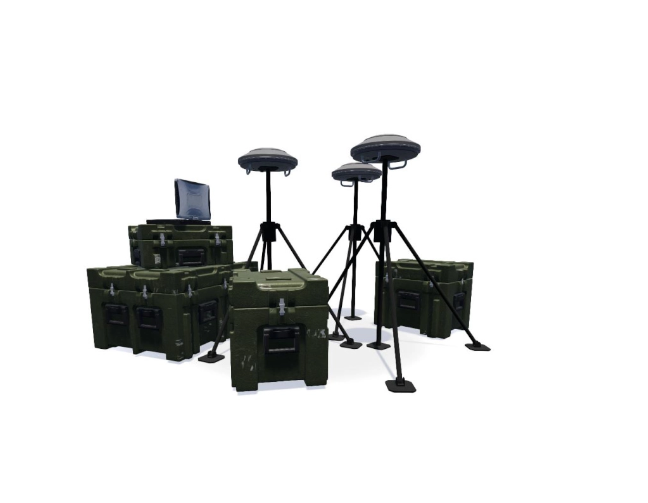Raytheon Intelligence & Space has developed a more lightweight ‘expeditionary’ version of its Joint Precision Approach Landing System to guide aircraft on final approach whether at sea or on land.
Part of Raytheon Intelligence & Space’s discussion about air dominance relates to the post-mission challenge of recovering pilots home safely. What began as a project that was originally developed to allow U.S. Navy and Marine Corps pilots to accurately find, then land, aircraft safely on ships at sea, is now being transferred to aircraft that operate from land.
One of Raytheon Intelligence and Space’s senior aviation advisors, retired U.S. Navy F/A-18 Hornet pilot Brooks Cleveland, has worked with the development of the Joint Precision Approach Landing System, known as JPALS, from its early days. Brooks flew the F/A-18 for the Navy for 20 years
“I was in charge of all the carrier landing training for the East Coast for the Atlantic Fleet [in relation to the safe operation of aircraft], so I did a lot of work at the initial stages of JPALS when I was on active duty – independent of Raytheon,” said Brooks.
JPALS is a software-based, high-integrity differential GPS navigation and precision approach landing system that guides an aircraft onto a carrier or an amphibious assault ship in all weather and surface conditions.
The JPALS program began in 2008 and has been operationally deployed since 2018. It is installed on all three variants of the F-35, but used primarily by the USMC and USN with the F-35B and F-35C variants on Marine amphibious carriers and Navy aircraft carriers. The first deployment was on the USS Wasp in 2018.
The MQ-25 unmanned platform is JPALS capable and other legacy aircraft are being considered by the Navy and Marine Corps.
eJPALS is born
Today, RI&S is bringing forward an expeditionary version of the system, known as eJPALS. Moving into the eJPALS user group includes a wider range of aircraft, such as the C-130 transport and F-16 fighters, as well as a range of helicopters. There is an opportunity to expand to legacy platforms based on the needs and missions of the services.
Working with eJPALS necessitates some aircraft compatibility, including software capability to receive the waveform coming from eJPALS and display the information to the pilot. GPS, which is installed on every modern aircraft, is also part of eJPALS.

The difference between instrument landing system and JPALS is the precision that the latter provides.
“When we started testing with the F/A-18, the hook was touching down within 10 centimeters every single time,” said Brooks, “so much so that we had to start moving the touchdown point.”
“On aircraft carrier, you can set it up to fly a 00 approach, so it’s coupled to the airplane. The autopilot is flying,” he said. “It’ll navigate the plane all the way down to a touchdown, although the pilot is still flying.
“If I’m out in a desert, either going to a runway or an unpaved landing zone, it is not moving. In an aircraft carrier, the engineering challenge was much greater because the deck is moving up, down, left, right and side-to-side as well as going forward while you’re trying to land. So, on the aircraft carrier, there’s a significant amount of engineering that goes into solving that problem. When we transitioned from the aircraft carrier to the expeditionary JPALS, it became a lot simpler,” explained Brooks.
In addition, it’s much smaller. eJPALS can be transported in four transit cases andpotentially less than that. This adaptability and weight reduction means that eJPALS is extremely mobile, which is exactly what expeditionary forces such as the Marine Corps need. It can be transported in a Humvee or JLTV and would include a user display, antennas, processing racks and a power generator, which is still a significant improvement over the current type of deployed land approach systems that often require a large footprint and extensive setup time.
By contrast, eJPALS requires about 15 minutes to set-up and another 45-60minutes for full synchronization with the GPS satellites for full operation use. It can be moved anywhere quickly, set up, torn down again, and bounced around as required by a rapidly moving mission. “It is responsive to where we’re going operationally, which is dispersed and adaptive,” commented Brooks, “linking through to the current military themes of sustaining operations in A2AD areas.”
Widespread Landing Zones
On land, eJPALS offers key advantages to an expeditionary force. Where an ILS can handle one straight approach, eJPALS can be put in the middle of the desert and guide airplanes to precision approach and landing out to 20 nautical miles and up to 50 airplanes at one time. Theoretically, there could have up to 50 individual touch down points.
In terms of rotorcraft, eJPALS gives the pilots an extra tool, and working in conjunction with some of their synthetic vision systems, provides improvement in ‘brown out’ conditions.
One practical illustration of a mobile eJPALS would be medivac Landing Zones within a couple of kilometres of any anywhere troops were going. If the eJPALS is placed inside a Forward Operating Base, it would be able to support those soldiers in all-weather conditions in a radius of 20 nautical miles.
by Andrew Drwiega


















.png)


Discussion about this post